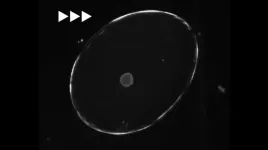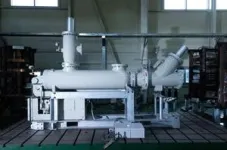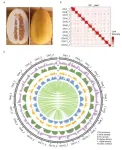(Press-News.org) Scientists have made a major breakthrough in the study of species evolution, and provided further evidence that state-of-the-art visual technology can be used to track the tiniest changes in different organisms’ development.
New research used a combination of robotic video microscopes and computer vision to measure all of the observable characteristics of embryos of three different species.
These measurements were recorded as spectra of energy and, through this, scientists were able to compare shifts between species alongside previously documented differences in the timing of discrete developmental events.
A detailed analysis of these so-called Energy Proxy Traits (EPTs) has provided researchers with the first evidence that traditionally measured timings of developmental events are associated with far broader changes to the full set of an embryo’s observable characteristics.
They also found huge changes in an embryo’s observable characteristics before and after the onset of each developmental event.
Writing in Frontiers in Physiology, the study’s authors say that applying lessons from the research has the potential to advance how development and evolution is studied, by enabling greater depth in the assessment of biological development and the ability to combine data across a wide range of species.
This is something, they add, that is particularly crucial at a time when climate and other environmental changes are having a significant – and in many cases harmful – impact on many parts of the natural world.
The study was led by scientists from the University of Plymouth’s EmbryoPhenomics Research Group, in the School of Biological and Marine Sciences, and builds on its 15-plus years of groundbreaking research into ways of monitoring embryo development.
Dr Jamie McCoy, a postdoctoral researcher – funded by the Biotechnology and Biological Sciences Research Council – and the study’s lead author, said: “The advances highlighted in this paper are critical to addressing the fundamental question of how species differ in the way that they develop. Measuring differences in the timings of development is one of the main ways in which researchers investigate how changes in development may drive evolution. But the results from our study suggest that measuring the timings of developmental events is just the tip of the iceberg in terms of how we measure and analyse evolutionary changes. By assessing EPTs across three different species, we have seen how they could provide us with an alternative approach to understanding how development leads to evolutionary change.”
The EPT method uses timelapse video of animals during their earliest and most dynamic life stages.
Each video is composed of a series of individual pixels, whose brightness fluctuates from one frame to the next as objects – such as a beating heart, muscle contractions, or spinning of the whole embryo driven by tiny hairs – move.
Researchers can exploit these fluctuations in pixel values and convert them into frequency data, allowing them to track a huge breadth of different aspects of the biology of the animal as it develops.
The resulting visuals mean that rather than choosing individual parts of the animal to measure, scientists can capture all of its traits – such as changes in heart rate or movement – and interrogate the resulting frequency data to capture a greater breadth of its biological response.
Dr Oliver Tills, senior author on the study, has been pioneering studies into embryo phenomics since 2007 and was in 2020 awarded a UK Research and Innovation Future Leaders Fellowship to advance his work. He added: “Our current understanding of biology is limited by the technologies available to observe it, and we need a new technology-enabled approach to understanding the most complex period of an organism’s life history. This study has broad implications for advancing our understanding of the nexus between biological development and evolution, and marks a significant step forward in how we might monitor the development of lifeforms all over our planet.”
Two decades of expertise in developmental biology
The EPT method used in the current study builds on pioneering work started almost 20 years ago using manual measurements.
That work was led by Dr Jennifer Smirthwaite and colleagues at the University of Plymouth and the Technical University of Munich, and documented a number of heterochronies – changes in the timings of developmental events between species – in a number of species of freshwater snail.
EPTs were applied to three species of freshwater snail from that study, and aimed to understand whether these evolutionary changes in the timings of development were associated with more high-dimensional changes to the phenotype.
END
Video technology could transform how scientists monitor changes in species evolution and development
2023-11-06
ELSE PRESS RELEASES FROM THIS DATE:
KERI developed an alternative technology for ‘SF6’, the main culprit of global warming
2023-11-06
Korea Electrotechnology Research Institute (KERI) has developed a world-class 'eco-friendly insulating gas' that replaces SF6 (sulfur hexafluoride), the main cause of global warming in the field of electric power equipment, and developed a design technology to make it applicable to ultra-high voltage transmission circuit breakers.
Of course, power devices must be able to conduct electricity well but an ‘insulation’ function to block electricity is also essential to prepare for unexpected accidents and for safety reasons. SF6 gas offers excellent insulation and with far superior arc extinguishing performance than any other ...
Emergency departments saw firearm injuries in children double during pandemic
2023-11-06
Pediatric Emergency Department (ED) visits for firearm injuries doubled during the pandemic compared to earlier trends, according to a multicenter study published in the journal Pediatrics. During this time, deaths from firearm injuries in children and adolescents that occurred after arrival to the hospital also doubled – up from 3 percent of ED visits pre-pandemic to 6 percent of ED visits during the pandemic.
“With the pandemic we saw a drastic increase in firearm purchases, which might have led to the tragic spikes in injuries and deaths from firearms among children ...
High biological age may increase the risk of dementia and stroke
2023-11-06
People who have a higher biological age than their actual chronological age have a significantly increased risk of stroke and dementia, especially vascular dementia. These are the results of a study from Karolinska Institutet in Sweden published in the Journal of Neurology, Neurosurgery and Psychiatry.
The study, which was led by Sara Hägg, associate professor, and Jonathan Mak, doctoral student at the Department of Medical Epidemiology and Biostatistics, Karolinska Institutet, shows that the increased risk persists even if other risk factors such as genetics, lifestyle and socioeconomics are taken into account.
As we age, the risk of chronic diseases such as ...
New research shows quasars can be buried in their host galaxies
2023-11-06
-With pictures-
A new study reveals that supermassive black holes at the centres of galaxies, known as quasars, can sometimes be obscured by dense clouds of gas and dust in their host galaxies.
This challenges the prevailing idea that quasars are only obscured by donut-shaped rings of dust in the close vicinity of the black hole.
Quasars are extremely bright objects powered by black holes gorging on surrounding material.
Their powerful radiation can be blocked if thick clouds come between us and the quasar.
Astronomers have long thought this obscuring material only exists in the quasar's immediate surroundings, in a "dusty torus" (or donut) encircling it.
Now, a team of ...
EMBARGOED: Bendy X-ray detectors could revolutionize cancer treatment
2023-11-06
EMBARGOED: 0001 GMT MONDAY 6 NOVEMBER 2023
New materials developed at the University of Surrey could pave the way for a new generation of flexible X-ray detectors, with potential applications ranging from cancer treatment to better airport scanners.
Traditionally, X-ray detectors are made of heavy, rigid material such as silicon or germanium. New, flexible detectors are cheaper and can be shaped around the objects that need to be scanned, improving accuracy when screening patients and reducing risk when imaging tumours and administering radiotherapy.
Dr Prabodhi Nanayakkara, ...
Real-world analysis of sodium-glucose cotransporter-2 inhibitors in kidney transplant recipients
2023-11-04
Highlights
Compared with kidney transplant recipients who did not receive sodium-glucose cotransporter-2 inhibitors, those treated with the medications had lower risks of experiencing kidney transplant failure, kidney transplant rejection, major adverse cardiac events, all-cause mortality, and genitourinary infections.
Results from the study will be presented at ASN Kidney Week 2023 November 1–November 5.
Philadelphia, PA (November 4, 2023) — Sodium-glucose cotransporter-2 (SGLT2) inhibitors lower blood sugar levels and have additional beneficial effects on kidney and heart health for individuals with ...
Diagnostic outcomes of concurrent DNA and RNA sequencing in individuals undergoing hereditary cancer testing
2023-11-04
About The Study: The findings of this diagnostic study including 43,000 individuals undergoing hereditary cancer testing demonstrate that the ability to perform RNA sequencing concurrently with DNA sequencing represents an important advancement in germline genetic testing by improving detection of novel variants and classification of existing variants. This expands the identification of individuals with hereditary cancer predisposition and increases opportunities for personalization of therapeutics and surveillance.
Authors: Rachid Karam, M.D., Ph.D., of Ambry Genetics ...
The first semi-wild-type melon T2T genome assembled by Zhengzhou Fruit Research Institute, Chinese Academy of Agricultural Sciences, and China Agricultural University
2023-11-03
Melon (Cucumis melo L.) is an important vegetable crop that has an extensive history of cultivation, and has been classified into two subspecies, C. melo ssp. agrestis and C. melo ssp. melo. Previous study suggested that the two subspecies were domesticated independently [1], which may have generated different genetic mechanisms for the same trait between the two subspecies. Furthermore, the difference in their geographical distribution resulted in diverse characteristics between the two subspecies, shaping genomic imprinting in their genomes. Wild germplasm is an important genetic resource in crop breeding because of its high genetic diversity ...
Neighborhood stressors dangerously elevate pregnancy hormones
2023-11-03
Pregnant women living in blighted neighborhoods with high levels of known stressors have higher levels of testosterone – the primary sex hormone in males -- which disrupt hormone regulation and may lead to life-threatening complications during and after childbirth, according to Rutgers research.
“Previous research has shown that exposure to neighborhood stressors is associated with preterm birth, low birth weight and other complications such as preeclampsia, gestational diabetes and stillbirth,” ...
Are results from clinical trials in kidney transplant recipients applicable to the real world?
2023-11-03
Highlights
Investigators have found demographic differences between participants of kidney transplant clinical trials and transplant recipients in the United States, even in recent years.
Results from the study will be presented at ASN Kidney Week 2023 November 1–November 5.
Philadelphia, PA (November 3, 2023) — Investigators recently examined the extent to which participants in clinical trials related to kidney transplantation are similar to individuals undergoing transplantation in the United States. The ...





